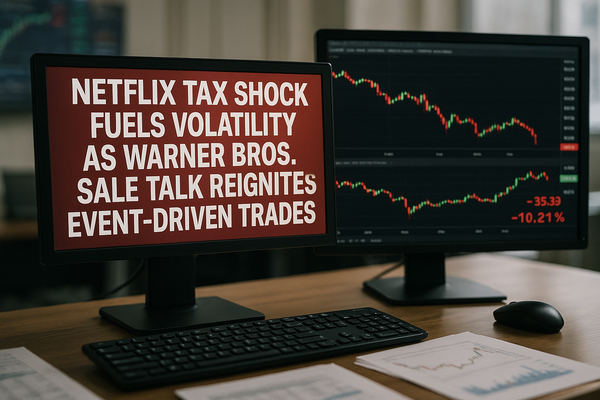
Netflix’s Brazil tax charge and Warner Bros. Discovery’s decision to explore strategic alternatives set the tone this week. The Brazil settlement produced an unexpected one-time hit that pushed Netflix shares noticeably lower. Warner Bros. Discovery’s sale process prompted a bidder rush and a sharp re-rating. In the short term traders are reacting to headline risk and earnings optics. Over months the developments could reshape M&A math, content monetization and cross-border tax risk for streaming. The news matters globally, from ad markets in the US to tax regimes in Latin America and consolidation activity in Europe and emerging markets.
Opening narrative: profits, taxes and a hunt for scale
Investors piled into content winners only to be reminded how fast sentiment can reverse. Netflix delivered a quarter with strong ad revenue and record engagement, but a $619 million Brazil tax settlement and a miss on adjusted EPS knocked the stock down and spooked momentum traders. At the same time Walt Disney’s improving streaming cash flow and an analyst upgrade lifted investor confidence that legacy studios can still extract value from direct-to-consumer businesses. Warner Bros. Discovery’s exploration of strategic alternatives added fuel to deal speculation, encouraging short-term buyers and pushing peers to reprice takeover and consolidation risk.
Streaming and content platforms: headline risk meets pricing power
Netflix remains the week’s largest story. Q3 results showed robust advertising growth and high engagement, yet the surprise Brazil tax expense pushed adjusted EPS below consensus. Shares fell about 9 to 10 percent on the print, reflecting a classic event-driven unwind. The tax hit underscores rising tax enforcement and transfer-pricing scrutiny for global streaming platforms. In the short run this creates volatility and squeezes leveraged event trades. Over the long run the episode raises the cost of cross-border expansion and could force companies to alter corporate structures or pricing strategies in Latin America and other jurisdictions.
Disney’s narrative was steadier. Analysts upgraded the stock to Buy, citing improving streaming margins and healthier theme park trends. Disney now benefits from both content licensing and owned distribution. That dual model reduces single-point-of-failure risk for investors and changes valuation comparatives across peers. Netflix’s miss, contrasted with Disney’s upgrade, is widening valuation gaps between pure-play streamers and diversified media operators, and will influence how traders size exposure to event risk versus structural cash-flow improvement.
Cable, broadband and distribution: cost cuts, subscriber mix, and competitive pressure
Charter’s workforce move to cut 1,200 management roles reverberated through the cable group. The company has been losing customers to wireline competitors and streaming alternatives, and the announcement coincided with a 5.2 percent intraday stock drop. Charter’s year-to-date and multi-year price declines signal investor concerns about secular cord-cutting and ARPU pressure. Comcast’s recent fair value tweak by analysts, shaving a few cents from prior targets while nudging the discount rate higher, shows the market is closely watching broadband subscriber trends and capital intensity on fiber rollouts.
These developments matter for banks and credit desks structuring relative-value trades. If broadband providers continue to lose video subscribers but grow higher-margin broadband, equity narratives will diverge from legacy cable valuations. Traders should watch guidance on subscriber adds, capex cadence and regulatory headwinds to recalibrate position sizing across distribution names.
Advertising, agencies and monetization: ad revenue resiliency and client budgets
Advertising data points are mixed but meaningful. Netflix reported record ad sales for the quarter, highlighting how monetization tiers can accelerate revenue growth and partially offset a tax-induced profit miss. Omnicom beat on Q3 organic growth of 2.6 percent and revenue of $4.04 billion, with adjusted EBITDA and EPS topping estimates. That suggests global ad budgets remain resilient enough to support agency revenues even as marketers demand measurable ROI. Pinterest is also getting attention as a monetization play, with commentary that it remains undervalued given Gen Z engagement and e-commerce pathways.
Macro pressure on ad spend typically follows tighter consumer wallets or slower GDP growth. For now agencies and ad-supported streamers show pockets of strength, but any deterioration in consumer spending or advertiser reallocation to AI-driven performance channels could pressure revenue multiples across the group.
Investor reaction: flows, volume and sentiment
Trader behavior this week split along event and consolidation lines. Netflix saw profit-taking from short-term holders after the earnings headline and tax disclosure. Warner Bros. Discovery experienced a surge in buying as the market priced in higher takeover probability; shares jumped more than 10 percent to new highs on the news and volume spiked as speculative and institutional players rotated into the stock.
Analyst adjustments were modest but notable. Disney earned an upgrade based on improving DTC margins and park recovery. Comcast’s slight fair-value revision signaled analysts’ caution on distribution monetization. These calls changed positioning in some mid-cap and large-cap media ETFs and prompted tactical rebalances in event-driven desks.
What to watch next
- Netflix follow-through and guidance. Investors will parse Q4 revenue cadence, the sustainability of ad sales, and any commentary on international tax exposure or structural changes to Latin America operations.
- Warner Bros. Discovery process updates. Any formal bid, banker appointments or exclusivity periods will be catalysts. Financing availability and interest-rate spreads will determine deal feasibility and pricing.
- Charter and Comcast subscriber reports. Broadband net adds, churn trends and ARPU guidance will shape distribution valuations and the risk premium on legacy video cash flows.
- Ad demand signals. Upcoming agency results and advertiser spending surveys will indicate whether ad budgets hold through the holiday quarter or reallocate toward performance channels and AI-driven spend.
- Regulatory and tax developments. Cross-border tax enforcement and any new guidance from Brazilian authorities could affect other global streamers and change how investors model international effective tax rates.
In the coming week traders should expect episodic volatility around company-specific catalysts. Event desks will likely remain active on takeover chatter for Warner Bros. Discovery, while macro-oriented desks watch ad budgets and subscriber trends for signs of durable momentum or further repricing.
Note: This report is informational market commentary and does not constitute trading advice.












